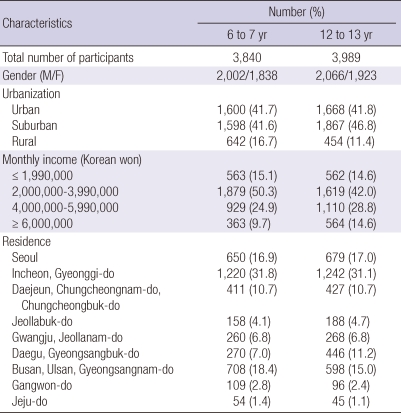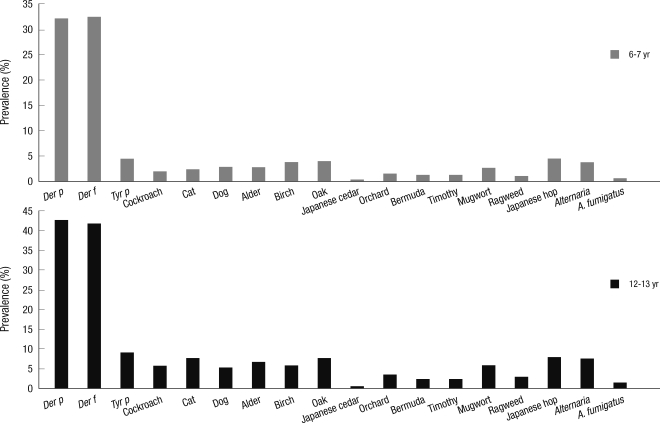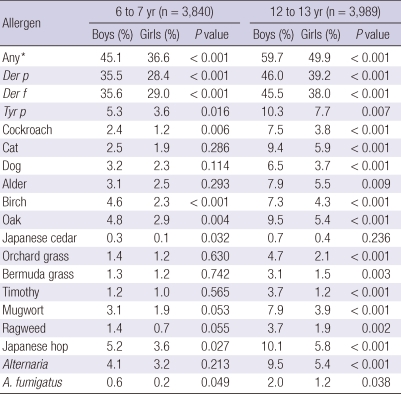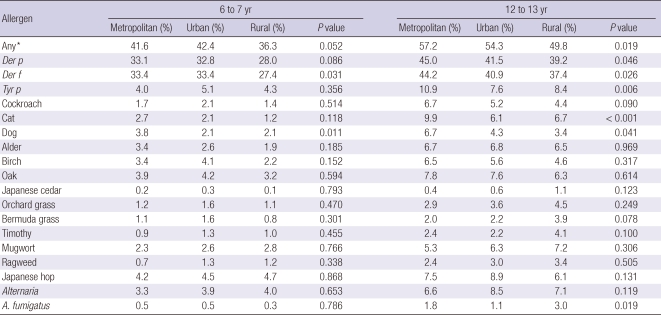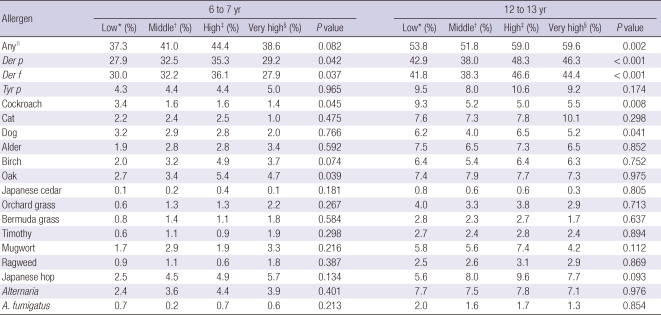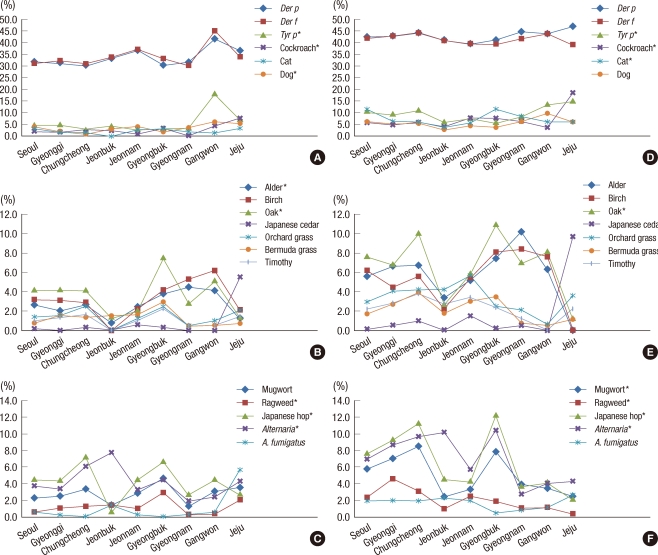Abstract
We performed this study to assess the prevalence of sensitization to aeroallergens and to analyze the difference between prevalence rates according to children's ages and residential areas. In this nationwide cross-sectional study, first grade students of 45 elementary schools and 40 middle schools were randomly selected, and skin prick tests were performed for 18 inhalant allergens between October and November 2010. Of 7,829 analyzed subjects, 3,753 (47.9%) were sensitized to at least one aeroallergen. Sensitization to Dermatophagoides farinae was found to be the most prevalent in elementary schoolchildren (32.4%), followed by Dermatophagoides pteronyssinus, Tyrophagus putrescentiae, Japanese hop, and oak. In middle schoolchildren, D. pteronyssinus yielded the highest prevalence (42.7%), followed by D. farinae, T. putrescentiae, Japanese hop, and cat. In middle schoolchildren, the sensitization rate to aeroallergens in metropolitan, urban, and rural areas was 57.2%, 54.3%, and 49.8%, respectively (P = 0.019). In this age group, the sensitization rate in low, middle, high, and very high income groups was 53.8%, 51.8%, 59.0%, and 59.6%, respectively (P = 0.002). In conclusion, the sensitization rate is 47.9% and house dust mite is the most prevalent allergen in the pediatric population in Korea. The rate is higher in metropolitan areas and the highest income group than in rural areas and low income groups.
Keywords: Skin Tests, Child, Dermatophagoides pteronyssinus, Dermatophagoides farinae
INTRODUCTION
Skin prick testing (SPT) is the standard method to assess IgE-mediated sensitization to inhalant allergens (1). It is a rapid, reproducible and accurate way of identifying the causative allergen of an IgE-mediated allergy (1). Allergic sensitization is a well-known important risk factor for asthma in adults and children (2). Early identification of those specific environmental allergies in children may assist in medical and environmental interventions in disease management (3). Sensitization to more than one indoor allergen is also common in atopic children and puts young adults at high risk of bronchial hyperresponsiveness (4).
Although previous studies have reported the sensitization rates of in Korea (5-12), those studies generally have been conducted on patients who have visited hospitals with suspected allergic symptoms. The studies of allergic sensitization in a general population sample of children have been performed in localized areas such as Seoul, Jeongeup, and Jeju (6, 7, 13). Although the most frequent allergens were not definitely shown in a study by Jung et al. (7), the rate of sensitization to more than one allergen was higher in Seoul than in Jeongeup. Dermatophagoides pteronyssinus (Der p), Dermatophagoides farinae (Der f), and Japanese cedar were the most frequent causes of sensitization in Jeju (13). In Korea, there was no nationwide study where sensitization rate to aeroallergen was evaluated according to the age and geographic distribution. In particular, the relative importance of different aeroallergens has rarely been assessed in the general population of Korean school children.
Although house dust mite (HDM), cat and cockroach allergens have been recognized as dominant allergens throughout different parts of the world, the impact of different allergens on allergic sensitization and morbidity in subjects with allergic diseases vary by countries and regions in each country (1, 3, 14). In addition, the distribution of inhalant allergens is changing as a result of climate change. In particular, ragweed-pollen production has been reported to be stimulated by increased atmospheric CO2 concentration (15), so evaluation of pollen sensitization in the general public is important to understand the clinical significance in allergic diseases.
In this context, the present study aimed to assess the prevalence of allergic sensitization and to analyze the difference between prevalence rates according to children's ages and residential areas. The choice of allergens was based on a previous study reporting the current use of allergens, high sensitization rates in Korea, climate change, and cross-reactivities. That strategy allowed the first determination of sensitization rates on the inhalant allergens of childhood and comparison according to children's ages and local residences in Korea.
MATERIALS AND METHODS
Selection of subjects
The study was carried out between October and November in 2010. To obtain a representative population, the survey was conducted in first grade students from 45 elementary schools (6-7 yr olds) and first grade students from 40 middle schools (12-13 yr olds). The sampling frame was based on a comprehensive national list of schools in Korea. The participants of this survey were selected using a stratified two-stage cluster sampling design. For the first stage of sampling, schools were stratified by geographic regions and the type of school location (metropolitan cities, urban areas, rural areas). From each stratum, sample schools were selected using the systematic probability proportional to size sampling procedure. The measure of size was the number of classes in the school. Before sample selection, the school frame was ordered by region, zip code, and school enrollment. The participation rates of originally sampled schools were 82% and 80% for the elementary and middle school respectively. The nonparticipating schools were substituted with "replacement schools" to meet the predetermined sample size. For the second stage of sampling, three classes were selected randomly within each sample school and all children in the sample classes were asked to take part in this survey. Parents were asked to complete questionnaires describing basic demographic information, including age, sex, region, urbanization, and monthly income of the family. We defined metropolitan areas as Seoul and 6 metropolitan cities, urban areas as cities, and rural areas as non-city areas ("gun"). Average monthly income level was classified into four categories: ≤ 1,990,000; 2,000,000-3,990,000; 4,000,000-5,990,000; and ≥ 6,000,000 Korean won.
Extracts and reagents
The following 18 inhalant allergens were selected for the standard SPT panel: Der p, Der f, Tyrophagus putrescentiae (Tyr p), cockroach, cat, dog, alder, birch, oak, Japanese cedar (Lofarma, Milan, Italy), orchard grass, bermuda grass, timothy, mugwort, ragweed, Japanese hop, Alternaria, and Aspergillus fumigatus. Histamine was used as a positive control and normal saline as a negative control. Unless otherwise stated, the allergens were provided by Allergopharma, Reinbek, Germany.
Skin prick tests
Testing solutions were stored at 2℃ to 8℃ when not in use. SPT was performed on the volar aspects of the forearms. A testing grid was fixed on the volar forearm surface of the student, and the orientation of the grid marked on the patient's arm. Numbers and dots were recorded 2 cm apart on volar forearms. A small drop of each testing solution was then placed next to the dot and the allergens applied in the same order for each test. For each allergen, a new 25 gauge needle was used that was then pressed against the skin in the center of the allergen drop without causing bleeding. After one minute, any excess solution was blotted with a tissue to avoid cross-contamination. After 15 min, wheal and flare reactions were determined by marking both reactions and copying the marks on a form via an adhesive tape.
The largest and perpendicular diameter of the wheal for each of the allergens was measured, and the following value was calculated: (largest + perpendicular diameter)/2. A test was regarded positive if the value calculated was ≥ 3 mm and controls showed adequate reactions. Patients were excluded if they had a negative histamine control.
Statistical analysis
SAS version 9.1, a statistical software package that takes into account the complex sample design features, was used for statistical analyses. Because the participants for this survey were selected using a stratified two-stage cluster sampling design, we constructed the sampling weights for this study to take into account differential selection probabilities, non-response and post-stratification. The chi-squared test using the SURVEYFREQ procedure of SAS version 9.1 was applied to estimating the differences of positive SPT by age and gender and to estimating the tests for trend for the area of residence. A P < 0.05 was considered to be significant.
Ethics statement
This study was approved by the institutional review board (IRB) at Dankook University in Cheonan (IRB approval number: DKUH IRB 2010-09-0260). Written informed consent was confirmed by the IRB and obtained from all parents prior to participation in this study.
RESULTS
Study population
A total of 7,829 valid data sets were analyzed. The demographic and geographical characteristics of the study population are demonstrated in Table 1. The study sample included 2,002 (52.1%) boys and 1,838 (47.9%) girls in elementary school and 2,066 (51.8%) boys and 1,923 (48.2%) girls in middle school. Residential areas during the study period were 1,096 (14.0%) rural, 3,465 (44.3%) urban, and 3,268 (41.7%) metropolitan, respectively.
Table 1.
Demographic characteristics of study population
Sensitization to aeroallergens by demographic characteristics
Of 7,829 analyzed subjects, 3,753 (47.9%) were sensitized to at least one of the aeroallergens, and the prevalence increased in children at 12 to 13 yr of age compared to those at 6 to 7 yr of age. The prevalence was 41.1% in subjects aged 6 to 7 yr, while it was 55.0% in those aged 12 to 13 yr. In addition, middle school students were more sensitized to all aeroallergens than elementary school students.
Overall, HDM was the most prevalent allergen causing positive SPT (Fig. 1). Sensitization to Der f was found to be the most prevalent in children aged 6 to 7 yr (32.4%), followed by Der p (32.1%), Tyr p (4.5%), Japanese hop (4.4%), and oak (3.9%). In the age group of 12 to 13 yr, Der p yielded the highest prevalence (42.7%), followed by Der f (41.9%), Tyr p (9.1%), Japanese hop (8.0%), and cat (7.7%) (Fig. 1).
Fig. 1.
Prevalence of positive skin prick tests to various aeroallergens is shown.
Boys were more likely to be sensitized to any allergen as compared to girls in all age groups (Table 2). In particular, significant gender differences were noted in Der p, Der f, Tyr p, cockroach, birch, oak, Japanese cedar, Japanese hop, and Aspergillus in subjects aged 6 to 7 yr and in all aeroallergens except Japanese cedar in those aged 12 to 13 yr.
Table 2.
Difference of sensitization rates to aeroallergens by age and gender
*At least one of the 18 allergens.
In the 6 to 7 yr age group, the sensitization to at least one of the 18 allergens was lower in rural areas compared to the metropolitan or urban areas, although there was no significant difference (P = 0.052) (Table 3). In this age group, sensitization to Der f was significantly lower in rural areas compared to the metropolitan or urban areas, and sensitization to dog was higher in the metropolitan area than others (P = 0.031 and 0.011, respectively). In the 12 to 13 yr of age group, sensitization to at least one of the 18 allergens was also the lowest in rural areas (P = 0.019) (Table 3). In this age group, sensitization to Der p, Der f, Tyr p, cat, and dog was highest in metropolitan areas (P = 0.046, 0.026, 0.006, < 0.001, and 0.041, respectively), but sensitization to Aspergillus was highest in rural areas (P = 0.019). There was no difference in sensitization to pollen by the urbanization in both age groups.
Table 3.
Difference of sensitization rates to aeroallergens by urbanization
*At least one of the 18 allergens.
The prevalence of sensitization to at least one of the 18 allergens in the 6 to 7 yr of age group was not associated with economic status, which was classified by monthly income (P = 0.082) (Table 4). In the 12 to 13 yr of age group, however, the higher sensitization rate of at least one of the 18 allergens was associated with the highest income group (P = 0.002) (Table 4). The middle class with a monthly income of 4,000,000-5,990,000 Korean won showed the second-highest sensitization rate in this age group. The prevalence of sensitization to Der p and Der f classified by monthly income was significantly high in the middle class group that had a monthly income of 4,000,000-5,990,000 Korean won in elementary school (P = 0.042 and 0.037, respectively) and middle school children (P < 0.001 and < 0.001, respectively). The group with a monthly income of 4,000,000-5,990,000 Korean won showed the highest prevalence of oak sensitization in elementary school children (P = 0.039) and dog sensitization in middle school children (P = 0.041). However, a higher prevalence of cockroach sensitization was associated with the lowest income group in elementary and middle schoolchildren (P = 0.045 and 0.008, respectively).
Table 4.
Difference of sensitization rates to aeroallergens by monthly income
*≤ 1,990,000 Korean won; †2,000,000-3,990,000 Korean won; ‡4,000,000-5,990,000 Korean won; §≥ 6,000,000 Korean won; ∥At least one of the 18 allergens.
Sensitization to aeroallergens by geographical locations
In elementary schoolchildren, sensitization to Tyr p was the most prominent in Gangwon-do (18.4%, P < 0.001), with dog sensitization (6.2%, P = 0.009). The highest rate of sensitization to cockroach was also seen in Jeju-do (7.7%, P < 0.001). Sensitization to Alder was the highest in Busan/Ulsan/Gyeongsangnam-do (4.5%, P = 0.049). Daegu/Gyeongsangbuk-do also showed the highest sensitization rate for oak and ragweed (7.6% and 2.9%, P = 0.017 and 0.043, respectively), and Daejeun/Chungcheongnam-do/Chungcheongbuk-do for Japanese hop (7.3%, P = 0.003). In addition, Alternaria sensitization was the most prevalent in Jeollabuk-do (7.8%, P = 0.015) (Fig. 2).
Fig. 2.
Sensitization rates to aeroallergens by geographical location are demonstrated. (A-C) show prevalence rates in children 6 to 7 yr of age, while (D-F) show those in children 12 to 13 yr of age. *< 0.05
In middle schoolchildren, Tyr p was the most prominent in Jeju-do (14.9%, P = 0.014), with cockroach sensitization (18.5%, P = 0.002). The highest rate of sensitization to cat was also seen in Seoul (11.4%, P < 0.001). Oak showed the highest SPT positivity in Daegu/Gyeongsangbuk-do (11.0%, P = 0.003), with Japanese hop and Alternaria (12.3% and 10.4%, P < 0.001 and < 0.001, respectively). Sensitizations to bermuda grass and mugwort were the highest in Daejeun/Chungcheongnam-do/Chungcheongbuk-do (3.9% and 8.5%, P = 0.013 and 0.002, respectively). In addition, Incheon/Gyeonggi-do showed the highest sensitization rate for ragweed (4.6%, P < 0.001).
DISCUSSION
This is the first nationwide, population-based study that evaluated sensitization to aeroallergens in Korean schoolchildren. These results are in accordance with worldwide reports that allergic sensitization has become a common condition. In our study, the prevalence of aeroallergen sensitization in elementary schoolchildren was 41.1%, while the prevalence in middle schoolchildren was 55.0%. The prevalence shows a similar level to results in other countries from 39% to 58%, although the dominating allergen is different in various geographic areas (16-18). In addition, our rates are similar to those found in other studies of sensitization in general schoolchildren in some restricted areas of Korea (6, 7). However, it is difficult to compare with the other Korean studies (5, 9, 12, 19), because most subjects in earlier studies were composed of referred patients for evaluation of possible atopic illnesses, not the general public. Furthermore, the results of the present study demonstrated that epidemiologically relevant allergens were different in each geographic area. The reason for this difference remains to be explained, but it has been suggested that the influence of environmental differences such as pollen distribution, temperature, and humidity plays an important role.
Der p and Der f were the most prevalent allergens in all age groups, and were evenly distributed throughout each region. Those results are consistent with other data reported in Korea (6, 12, 19). Some studies in China and Turkey have reported that HDM was the most common allergen (18, 20), while those in Estonia and Europe have pointed to grasses and cockroach as dominating allergens (1, 14, 21). Tyr p, which is known to be a storage mite, was the dominating sensitizer in Gangwon and Jeju-do. Storage mites that were usually found in rural areas or warehouses, have prevailed in previous studies that mainly involved farmers, but those studies were reported to have clinical significance for allergies in city dwellers (5, 22, 23). There is also the possibility of cross-reactivity between Dermatophagoides and Tyrophagus (24). Sensitization rates to dogs or cats were lower than those in other countries (1, 25), indicating that levels of pet exposure were low in Korea. It is inferred that environmental control could have an impact on allergic sensitization, because positive correlations were reported between the community prevalence of cat and the prevalence of sensitization to cats (26). Sensitization to each pollen revealed obvious differences according to local areas in this study. In particular, Japanese cedar sensitization was the most prevalent in Jeju-do, as in other reports (6, 11, 13). It has been well known that Jeju-do has plenty of Japanese cedar on mandarin orange farms to protect against the wind (6).
Oh et al. (9) reported that sensitization rates for outdoor airborne pollens have increased in Korean children with suspected allergic diseases. They also presented an increase in pollen count including ragweed in a nationwide pollen counting survey (9). Although characteristics of those subjects are different from ours, it would be interesting to note whether this trend might be observed in the general population. It might be helpful for identification of the trend in pollen sensitization to study the population using the same allergen panel and analyze the association between sensitization rate and pollen count over the next few years.
It was noteworthy that, in our study, boys had higher rates of aeroallergen sensitization than girls, supporting the earlier studies that reported in which males have more atopy compared to females (3, 6), although the reason for that is not entirely understood. In addition, children in metropolitan or urban areas showed higher prevalence of sensitization to aeroallergens than in rural areas. This finding corresponds with the results of a recent study, which reported that the sensitization rate was higher in Seoul than in Jeongeup (7). This might be either because urban environmental irritants promote the development of allergic sensitization or because rural environmental factors have the protective the role, which is compatible with hygiene hypothesis (27). An increased sensitization rate was also observed in the highest income group. The reason for this difference does not exclude the possibility that people living in metropolitan or urban areas have higher incomes than those in rural areas (28). The higher prevalence of cockroach sensitization was associated with the lowest income group. There is a controversy as to whether cockroach sensitization is associated with economic state (29, 30). However, it is presumed that hygiene practices in homes or local community might affect the cockroach sensitization.
In conclusion, the prevalence of sensitization to aeroallergen in a population study of Korea is 41.1% in 6-7 yr olds and 55.0% in 12-13 yr olds. Sensitization rates were different according to urbanization, monthly income state, and geographic locations. The most common allergens are HDM, but relevant allergens are different according to regional location. These data would be beneficial to investigate change in sensitization rates by change in climate or life style over time and to establish national policies related to allergic diseases.
ACKNOWLEDGMENTS
We thank the entire survey team, including the field supervisors, field workers, and pediatricians. We also thank all participants in this survey for their invaluable devotion and assistance.
Footnotes
This research was supported by a fund (2010E3303400) by Research of Korea Centers for Disease Control and Prevention.
AUTHOR SUMMARY
Sensitization to Aeroallergens in Korean Children: A Population-based Study in 2010
Jihyun Kim, Myung-Il Hahm, So-Yeon Lee, Woo Kyung Kim, Yoomi Chae, Yong Mean Park, Man Yong Han, Kee-Jae Lee, Ho-Jang Kwon, Jin-A Jung, Su Young Kim and Kangmo Ahn
This study shows that house dust mite is the most prevalent allergen in the pediatric population in Korea, and the higher sensitization rate is shown in metropolitan areas and the highest income group.
References
- 1.Heinzerling LM, Burbach GJ, Edenharter G, Bachert C, Bindslev-Jensen C, Bonini S, Bousquet J, Bousquet-Rouanet L, Bousquet PJ, Bresciani M, Bruno A, Burney P, Canonica GW, Darsow U, Demoly P, Durham S, Fokkens WJ, Giavi S, Gjomarkaj M, Gramiccioni C, Haahtela T, Kowalski ML, Magyar P, Muraközi G, Orosz M, Papadopoulos NG, Röhnelt C, Stingl G, Todo-Bom A, von Mutius E, Wiesner A, Wöhrl S, Zuberbier T. GA(2)LEN skin test study I: GA(2)LEN harmonization of skin prick testing: novel sensitization patterns for inhalant allergens in Europe. Allergy. 2009;64:1498–1506. doi: 10.1111/j.1398-9995.2009.02093.x. [DOI] [PubMed] [Google Scholar]
- 2.Pallasaho P, Rönmark E, Haahtela T, Sovijärvi AR, Lundbäck B. Degree and clinical relevance of sensitization to common allergens among adults: a population study in Helsinki, Finland. Clin Exp Allergy. 2006;36:503–509. doi: 10.1111/j.1365-2222.2006.02460.x. [DOI] [PubMed] [Google Scholar]
- 3.Sheehan WJ, Rangsithienchai PA, Baxi SN, Gardynski A, Bharmanee A, Israel E, Phipatanakul W. Age-specific prevalence of outdoor and indoor aeroallergen sensitization in Boston. Clin Pediatr (Phila) 2010;49:579–585. doi: 10.1177/0009922809354326. [DOI] [PMC free article] [PubMed] [Google Scholar]
- 4.Kerkhof M, Postma DS, Schouten JP, de Monchy JG. Allergic sensitization to indoor and outdoor allergens and relevance to bronchial hyperresponsiveness in younger and older subjects. Allergy. 2003;58:1261–1267. doi: 10.1046/j.1398-9995.2003.00020.x. [DOI] [PubMed] [Google Scholar]
- 5.Choi BS, Lee YJ, Baek JY, Kim KW, Sohn MH, Kim KE. Prevalence of sensitization to Tyrophagus putrescentiae in children with allegic diseases. Pediatr Allergy Respir Dis. 2010;20:107–113. [Google Scholar]
- 6.Jeon B, Lee J, Kim JH, Kim JW, Lee HS, Lee KH. Atopy and sensitization rates to aeroallergens in children and teenagers in Jeju, Korea. Korean J Asthma Allergy Clin Immunol. 2010;30:14–20. [Google Scholar]
- 7.Jung HH, Kwon JW, Lee SY, Seo JH, Song YH, Kim BJ, Kim HB, Yu J, Hong SJ, Park KS. Correlation between demographic characteristics and indoor allergen sensitization among Jeongeup countryside, Jeongeup city, and Seoul city in Korea. Korean J Asthma Allergy Clin Immunol. 2010;30:277–284. [Google Scholar]
- 8.Kwak HJ, Kim SH, Kim TH, Sohn JW, Shin DH, Park SS, Yoon HJ. Prevalence of sensitization rates to inhalant allergens and airway hyperresponsiveness among medical students in Seoul. Korean J Asthma Allergy Clin Immunol. 2009;29:166–170. [Google Scholar]
- 9.Oh JW, Kang IJ, Kim SW, Kook MH, Kim BS, Shin KS, Hahn YS, Lee HB, Shon MH, Cheong JT, Lee HR, Kim KE. The correlation between increased sensitization rate to weeds in children and the annual increase in weed pollen in Korea. Pediatr Allergy Respir Dis. 2006;16:114–121. [Google Scholar]
- 10.Yu J, Yoo Y, Kang H, Kim DK, Choi SH, Koh YY. The relationship between allergen sensitization and bronchial hyperresponsiveness in children aged 6-8 years. Pediatr Allergy Respir Dis. 2005;15:344–351. [Google Scholar]
- 11.Kim TB, Kim KM, Kim SH, Kang HR, Chang YS, Kim CW, Bahn JW, Kim YK, Kang HT, Cho SH, Park HS, Lee JM, Choi IS, Min KU, Hong CS, Kim NS, Kim YY. Sensitization rates for inhalant allergens in Korea: a multi-center study. J Asthma Allergy Clin Immunol. 2003;23:483–493. [Google Scholar]
- 12.Kim YJ, Han JE, Kang IJ. Change of inhalant allergen sensitization in children with allergic respiratory diseases during recent 10 years. Korean J Asthma Allergy Clin Immunol. 2004;24:241–246. [Google Scholar]
- 13.Lee MH, Hong SC, Kim TB, Son SW, Jang YS, Kim SH, Chung JW, Kim YK, Cho SH, Min KU, Kim YY. A prospective study of asthma prevalence and atopy rate in children living in rural area of Cheju island for 3 years. Pediatr Allergy Respir Dis. 2001;11:224–232. [Google Scholar]
- 14.Raukas-Kivioja A, Raukas ES, Meren M, Loit HM, Rönmark E, Lundbäck B. Allergic sensitization to common airborne allergens among adults in Estonia. Int Arch Allergy Immunol. 2007;142:247–254. doi: 10.1159/000097027. [DOI] [PubMed] [Google Scholar]
- 15.Wayne P, Foster S, Connolly J, Bazzaz F, Epstein P. Production of allergenic pollen by ragweed (Ambrosia artemisiifolia L.) is increased in CO2-enriched atmospheres. Ann Allergy Asthma Immunol. 2002;88:279–282. doi: 10.1016/S1081-1206(10)62009-1. [DOI] [PubMed] [Google Scholar]
- 16.von Mutius E, Schwartz J, Neas LM, Dockery D, Weiss ST. Relation of body mass index to asthma and atopy in children: the National Health and Nutrition Examination Study III. Thorax. 2001;56:835–838. doi: 10.1136/thorax.56.11.835. [DOI] [PMC free article] [PubMed] [Google Scholar]
- 17.Stern DA, Lohman IC, Wright AL, Taussig LM, Martinez FD, Halonen M. Dynamic changes in sensitization to specific aeroallergens in children raised in a desert environment. Clin Exp Allergy. 2004;34:1563–1669. doi: 10.1111/j.1365-2222.2004.02088.x. [DOI] [PubMed] [Google Scholar]
- 18.Jin Y, Wang W, Xu Y, Zhao J, Liu H, Xue S. Familial aggregation of skin sensitization to aeroallergens in a rural area in China. Int Arch Allergy Immunol. 2009;148:81–86. doi: 10.1159/000151509. [DOI] [PubMed] [Google Scholar]
- 19.Kim KH, Kim KT, Lee SK, Park HS, Lee YM, Nahm DH, Son CH, Yang DK, Roh MS, Choi PJ, Lee JH, Kim KN, Lee KN. Sensitization rates for inhalant allergens in patients with respiratory allergy in Busan. Korean J Asthma Allergy Clin Immunol. 2005;25:59–63. [Google Scholar]
- 20.Dibek Misirlioğlu E, Reha Cengizlier M. Skin prick test results of child patients diagnosed with bronchial asthma. Allergol Immunopathol Madr (Madr) 2007;35:21–24. doi: 10.1157/13099091. [DOI] [PubMed] [Google Scholar]
- 21.Kaleyias J, Papaioannou D, Manoussakis M, Syrigou E, Tapratzi P, Saxoni-Papageorgiou P. Skin-prick test findings in atopic asthmatic children: a follow-up study from childhood to puberty. Pediatr Allergy Immunol. 2002;13:368–374. doi: 10.1034/j.1399-3038.2002.02077.x. [DOI] [PubMed] [Google Scholar]
- 22.Kronqvist M, Johansson E, Pershagen G, Johansson SG, van Hage-Hamsten M. Increasing prevalence of asthma over 12 years among dairy farmers on Gotland, Sweden: storage mites remain dominant allergens. Clin Exp Allergy. 1999;29:35–41. doi: 10.1046/j.1365-2222.1999.00452.x. [DOI] [PubMed] [Google Scholar]
- 23.Kronqvist M, Johansson E, Pershagen G, Johansson SG, van Hage-Hamsten M. Risk factors associated with asthma and rhinoconjunctivitis among Swedish farmers. Allergy. 1999;54:1142–1149. doi: 10.1034/j.1398-9995.1999.00115.x. [DOI] [PubMed] [Google Scholar]
- 24.Park JW, Ko SH, Yong TS, Ree HI, Jeoung BJ, Hong CS. Cross-reactivity of Tyrophagus putrescentiae with Dermatophagoides farinae and Dermatophagoides pteronyssinus in urban areas. Ann Allergy Asthma Immunol. 1999;83:533–539. doi: 10.1016/S1081-1206(10)62865-7. [DOI] [PubMed] [Google Scholar]
- 25.Asarnoj A, Ostblom E, Kull I, Lilja G, Pershagen G, Hedlin G, van Hage M, Wickman M. Sensitization to inhalant allergens between 4 and 8 years of age is a dynamic process: results from the BAMSE birth cohort. Clin Exp Allergy. 2008;38:1507–1513. doi: 10.1111/j.1365-2222.2008.03046.x. [DOI] [PMC free article] [PubMed] [Google Scholar]
- 26.Roost HP, Künzli N, Schindler C, Jarvis D, Chinn S, Perruchoud AP, Ackermann-Liebrich U, Burney P, Wüthrich B. Role of current and childhood exposure to cat and atopic sensitization. European Community Respiratory Health Survey. J Allergy Clin Immunol. 1999;104:941–947. doi: 10.1016/s0091-6749(99)70072-2. [DOI] [PubMed] [Google Scholar]
- 27.von Mutius E. Influences in allergy: epidemiology and the environment. J Allergy Clin Immunol. 2004;113:373–379. doi: 10.1016/j.jaci.2003.12.040. quiz 380. [DOI] [PubMed] [Google Scholar]
- 28.Lee DP, Park SH, Kim TY, Seong JI, Shin EJ, Kim JH, Kim CH. The analysis of the reasons for income and development gap between urban and rural regions. [accessed on 28 July 2011]. Available at http://imd.krei.re.kr:8888/pdf/pdfsource/89417p.pdf.
- 29.Majkowska-Wojciechowska B, Pełka J, Korzon L, Kozłowska A, Kaczała M, Jarzebska M, Gwardys T, Kowalski ML. Prevalence of allergy, patterns of allergic sensitization and allergy risk factors in rural and urban children. Allergy. 2007;62:1044–1050. doi: 10.1111/j.1398-9995.2007.01457.x. [DOI] [PubMed] [Google Scholar]
- 30.Wilson NW, Robinson NP, Hogan MB. Cockroach and other inhalant allergies in infantile asthma. Ann Allergy Asthma Immunol. 1999;83:27–30. doi: 10.1016/S1081-1206(10)63509-0. [DOI] [PubMed] [Google Scholar]



